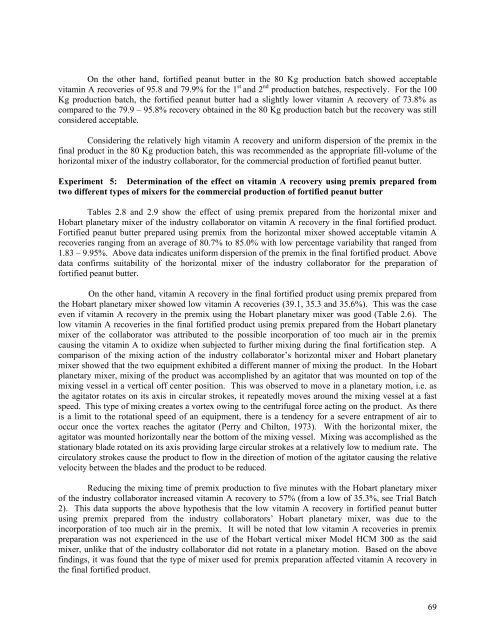VITAMIN A FORTIFIed PEANUT BUTTER - The Official Website of ...
VITAMIN A FORTIFIed PEANUT BUTTER - The Official Website of ...
VITAMIN A FORTIFIed PEANUT BUTTER - The Official Website of ...
Create successful ePaper yourself
Turn your PDF publications into a flip-book with our unique Google optimized e-Paper software.
On the other hand, fortified peanut butter in the 80 Kg production batch showed acceptable<br />
vitamin A recoveries <strong>of</strong> 95.8 and 79.9% for the 1 st and 2 nd production batches, respectively. For the 100<br />
Kg production batch, the fortified peanut butter had a slightly lower vitamin A recovery <strong>of</strong> 73.8% as<br />
compared to the 79.9 – 95.8% recovery obtained in the 80 Kg production batch but the recovery was still<br />
considered acceptable.<br />
Considering the relatively high vitamin A recovery and uniform dispersion <strong>of</strong> the premix in the<br />
final product in the 80 Kg production batch, this was recommended as the appropriate fill-volume <strong>of</strong> the<br />
horizontal mixer <strong>of</strong> the industry collaborator, for the commercial production <strong>of</strong> fortified peanut butter.<br />
Experiment 5: Determination <strong>of</strong> the effect on vitamin A recovery using premix prepared from<br />
two different types <strong>of</strong> mixers for the commercial production <strong>of</strong> fortified peanut butter<br />
Tables 2.8 and 2.9 show the effect <strong>of</strong> using premix prepared from the horizontal mixer and<br />
Hobart planetary mixer <strong>of</strong> the industry collaborator on vitamin A recovery in the final fortified product.<br />
Fortified peanut butter prepared using premix from the horizontal mixer showed acceptable vitamin A<br />
recoveries ranging from an average <strong>of</strong> 80.7% to 85.0% with low percentage variability that ranged from<br />
1.83 – 9.95%. Above data indicates uniform dispersion <strong>of</strong> the premix in the final fortified product. Above<br />
data confirms suitability <strong>of</strong> the horizontal mixer <strong>of</strong> the industry collaborator for the preparation <strong>of</strong><br />
fortified peanut butter.<br />
On the other hand, vitamin A recovery in the final fortified product using premix prepared from<br />
the Hobart planetary mixer showed low vitamin A recoveries (39.1, 35.3 and 35.6%). This was the case<br />
even if vitamin A recovery in the premix using the Hobart planetary mixer was good (Table 2.6). <strong>The</strong><br />
low vitamin A recoveries in the final fortified product using premix prepared from the Hobart planetary<br />
mixer <strong>of</strong> the collaborator was attributed to the possible incorporation <strong>of</strong> too much air in the premix<br />
causing the vitamin A to oxidize when subjected to further mixing during the final fortification step. A<br />
comparison <strong>of</strong> the mixing action <strong>of</strong> the industry collaborator’s horizontal mixer and Hobart planetary<br />
mixer showed that the two equipment exhibited a different manner <strong>of</strong> mixing the product. In the Hobart<br />
planetary mixer, mixing <strong>of</strong> the product was accomplished by an agitator that was mounted on top <strong>of</strong> the<br />
mixing vessel in a vertical <strong>of</strong>f center position. This was observed to move in a planetary motion, i.e. as<br />
the agitator rotates on its axis in circular strokes, it repeatedly moves around the mixing vessel at a fast<br />
speed. This type <strong>of</strong> mixing creates a vortex owing to the centrifugal force acting on the product. As there<br />
is a limit to the rotational speed <strong>of</strong> an equipment, there is a tendency for a severe entrapment <strong>of</strong> air to<br />
occur once the vortex reaches the agitator (Perry and Chilton, 1973). With the horizontal mixer, the<br />
agitator was mounted horizontally near the bottom <strong>of</strong> the mixing vessel. Mixing was accomplished as the<br />
stationary blade rotated on its axis providing large circular strokes at a relatively low to medium rate. <strong>The</strong><br />
circulatory strokes cause the product to flow in the direction <strong>of</strong> motion <strong>of</strong> the agitator causing the relative<br />
velocity between the blades and the product to be reduced.<br />
Reducing the mixing time <strong>of</strong> premix production to five minutes with the Hobart planetary mixer<br />
<strong>of</strong> the industry collaborator increased vitamin A recovery to 57% (from a low <strong>of</strong> 35.3%, see Trial Batch<br />
2). This data supports the above hypothesis that the low vitamin A recovery in fortified peanut butter<br />
using premix prepared from the industry collaborators’ Hobart planetary mixer, was due to the<br />
incorporation <strong>of</strong> too much air in the premix. It will be noted that low vitamin A recoveries in premix<br />
preparation was not experienced in the use <strong>of</strong> the Hobart vertical mixer Model HCM 300 as the said<br />
mixer, unlike that <strong>of</strong> the industry collaborator did not rotate in a planetary motion. Based on the above<br />
findings, it was found that the type <strong>of</strong> mixer used for premix preparation affected vitamin A recovery in<br />
the final fortified product.<br />
69


